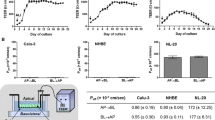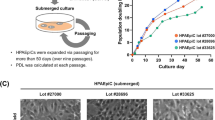Abstract
Purpose
To evaluate the inflammatory response and barrier formation of a new alveolar type 1-like (transformed type I; TT1) cell line to establish its suitability for toxicity and drug transport studies.
Methods
TT1 and A549 cells were challenged with lipopolysaccharide (LPS). Secretion of inflammatory mediators was quantified by ELISA. The barrier properties of TT1 cells were evaluated by transepithelial electrical resistance (TEER), fluorescein sodium (flu-Na) apparent permeability (P app) and staining of zona occludens-1 (ZO-1).
Results
LPS stimulated similar levels of secretion of IL-6 and IL-8 in TT1 and A549 cells. TNF-α was not produced by either cell line. In contrast to A549 cells, TT1 cells did not secrete SLPI or elafin. TT1 cells produced maximal TEER of ~55 Ω cm2 and flu-Na P app of ~6.0 × 10−6 cm/s. ZO-1 staining was weak and discontinuous. Attempts to optimise culture conditions did not increase the barrier properties of the TT1 cell layers.
Conclusions
The TT1 cell line models the alveolar inflammatory response to LPS challenge and provides a valuable complement to cell lines currently used in toxicity assays. However, under the experimental conditions used the TT1 cell line did not form the highly restrictive tight junctions which exist in vivo.




Similar content being viewed by others
Abbreviations
- AT1:
-
alveolar type 1
- AT2:
-
alveolar type 2
- flu-Na:
-
fluorescein sodium
- P app :
-
apparent permeability coefficient
- SLPI:
-
secretory leukoprotease inhibitor
- TEER:
-
transepithelial resistance
- TT1:
-
transformed type 1
- ZO-1:
-
zona occludens protein-1
References
J. D. Crapo, B. E. Barry, P. Gehr, M. Bachofen, and E. R. Weibel. Cell number and cell characteristics of the normal human lung. Am. Rev. Respir Dis. 126:332–337 (1982).
J. M. Cheek, K. J. Kim, and E. D. Crandall. Tight monolayers of rat alveolar epithelial cells: bioelectric properties and active sodium transport. Am. J. Physiol. 256:C688–693 (1989).
A. N. Dodoo, S. S. Bansal, D. J. Barlow, F. Bennet, R. C. Hider, A. B. Lansley, M. J. Lawrence, and C. Marriott. Use of alveolar cell monolayers of varying electrical resistance to measure pulmonary peptide transport. J. Pharm. Sci. 89:223–231 (2000). doi:10.1002/(SICI)1520-6017(200002)89:2<223::AID-JPS9>3.0.CO;2-R.
Y. Matsukawa, H. Yamahara, F. Yamashita, V. H. Lee, E. D. Crandall, and K. J. Kim. Rates of protein transport across rat alveolar epithelial cell monolayers. J. Drug Target. 7:335–342 (2000).
M. D. Johnson, J. H. Widdicombe, L. Allen, P. Barbry, and L. G. Dobbs. Alveolar epithelial type I cells contain transport proteins and transport sodium, supporting an active role for type I cells in regulation of lung liquid homeostasis. Proc. Natl. Acad. Sci. U. S. A. 99:1966–1971 (2002) doi:10.1073/pnas.042689399.
H. Fehrenbach. Alveolar epithelial type II cell: defender of the alveolus revisited. Respir. Res. 2:33–46 (2001) doi:10.1186/rr36.
G. Diamond, D. Legarda, and L. K. Ryan. The innate immune response of the respiratory epithelium. Immunol. Rev. 173:27–38 (2000) doi:10.1034/j.1600-065X.2000.917304.x.
E. L. Roggen, N. K. Soni, and G. R. Verheyen. Respiratory immunotoxicity: an in vitro assessment. Toxicol. In Vitro. 20:1249–1264 (2006) doi:10.1016/j.tiv.2006.03.009.
S. J. Kemp, A. J. Thorley, J. Gorelik, M. J. Seckl, M. J. O’Hare, A. Arcaro, Y. Korchev, P. Goldstraw, and T. D. Tetley. Immortalisation of human alveolar epithelial cells to investigate nanoparticle uptake. Am. J. Respir. Cell. Mol. Biol. 39:591–597 (2008) doi:10.1165/rcmb.2007-0334OC.
K. J. Kim, Z. Borok, and E. D. Crandall. A useful in vitro model for transport studies of alveolar epithelial barrier. Pharm. Res. 18:253–255 (2001) doi:10.1023/A:1011040824988.
F. Blank, B. M. Rothen-Rutishauser, S. Schurch, and P. Gehr. An optimized in vitro model of the respiratory tract wall to study particle cell interactions. J. Aerosol. Med. 19:392–405 (2006) doi:10.1089/jam.2006.19.392.
L. Horalkova, S. Endter, R. Koslowski, and C. Ehrhardt. Characteristics of the rat alveolar epithelial type I-like cell line R3/1 for use as an in vitro model of pulmonary drug disposition. Eur. J. Pharm. Sci. (2008), doi:10.1016/j.ejps.2008.11.010
R. Koslowski, K. Barth, A. Augstein, T. Tschernig, G. Bargsten, M. Aufderheide, and M. Kasper. A new rat type I-like alveolar epithelial cell line R3/1: bleomycin effects on caveolin expression. Histochem. Cell. Biol. 121:509–519 (2004) doi:10.1007/s00418-004-0662-4.
A. Luhrmann, G. Bargsten, M. Kuzu, R. Koslowski, R. Pabst, and T. Tschernig. The alveolar epithelial type I-like cell line as an adequate model for leukocyte migration studies in vitro. Exp. Toxicol. Pathol. 58:277–283 (2007) doi:10.1016/j.etp.2006.09.002.
M. P. Steele, R. A. Levine, M. Joyce-Brady, and J. S. Brody. A rat alveolar type II cell line developed by adenovirus 12SE1A gene transfer. Am. J. Respir. Cell. Mol. Biol. 6:50–56 (1992).
K. J. Kim. Models for investigation of peptide and protein transport across cultured mammalian respiratory epithelial barriers. In R. T. Borchardt (ed.), Models for Assessing Drug Absorption and Metabolism, Plenum, New York, 1996, pp. 325–346.
A. Steimer, H. Franke, E. Haltner-Ukomado, M. Laue, C. Ehrhardt, and C.M. Lehr. Monolayers of porcine alveolar epithelial cells in primary culture as an in vitro model for drug absorption studies. Eur. J. Pharm. Biopharm. 66:372–382 (2007) doi:10.1016/j.ejpb.2006.11.006.
M. Bur, H. Huwer, C. M. Lehr, N. Hagen, M. Guldbrandt, K. J. Kim, and C. Ehrhardt. Assessment of transport rates of proteins and peptides across primary human alveolar epithelial cell monolayers. Eur. J. Pharm. Sci. 28:196–203 (2006) doi:10.1016/j.ejps.2006.02.002.
K. J. Elbert, U. F. Schafer, H. J. Schafers, K. J. Kim, V. H. Lee, and C. M. Lehr. Monolayers of human alveolar epithelial cells in primary culture for pulmonary absorption and transport studies. Pharm. Res. 16:601–608 (1999) doi:10.1023/A:1018887501927.
M. I. Hermanns, R. E. Unger, K. Kehe, K. Peters, and C. J. Kirkpatrick. Lung epithelial cell lines in coculture with human pulmonary microvascular endothelial cells: development of an alveolo-capillary barrier in vitro. Lab. Invest. 84:736–752 (2004) doi:10.1038/labinvest.3700081.
A. S. Fanning, B. J. Jameson, L. A. Jesaitis, and J. M. Anderson. The tight junction protein ZO-1 establishes a link between the transmembrane protein occludin and the actin cytoskeleton. J. Biol. Chem. 273:29745–29753 (1998) doi:10.1074/jbc.273.45.29745.
G. Imanidis, C. Waldner, C. Mettler, and H. Leuenberger. An improved diffusion cell design for determining drug transport parameters across cultured cell monolayers. J. Pharm. Sci. 85:1196–1203 (1996) doi:10.1021/js960102g.
Q. M. Ningand, and X. R. Wang. Response of alveolar type II epithelial cells to mechanical stretch and lipopolysaccharide. Respiration. 74:579–585 (2007) doi:10.1159/000101724.
C. Schulz, L. Farkas, K. Wolf, K. Kratzel, G. Eissner, and M. Pfeifer. Differences in LPS-induced activation of bronchial epithelial cells (BEAS-2B) and type II-like pneumocytes (A-549). Scand. J. Immunol. 56:294–302 (2002) doi:10.1046/j.1365-3083.2002.01137.x.
C. Monteiller, L. Tran, W. MacNee, S. Faux, A. Jones, B. Miller, and K. Donaldson. The pro-inflammatory effects of low-toxicity low-solubility particles, nanoparticles and fine particles, on epithelial cells in vitro: the role of surface area. Occup. Environ. Med. 64:609–615 (2007) doi:10.1136/oem.2005.024802.
C. M. Sayes, K. L. Reed, and D. B. Warheit. Assessing toxicity of fine and nanoparticles: comparing in vitro measurements to in vivo pulmonary toxicity profiles. Toxicol. Sci. 97:163–180 (2007) doi:10.1093/toxsci/kfm018.
C. C. dos Santos, B. Han, C. F. Andrade, X. Bai, S. Uhlig, R. Hubmayr, M. Tsang, M. Lodyga, S. Keshavjee, A. S. Slutsky, and M. Liu. DNA microarray analysis of gene expression in alveolar epithelial cells in response to TNFalpha, LPS, and cyclic stretch. Physiol. Genomics. 19:331–342 (2004) doi:10.1152/physiolgenomics.00153.2004.
A. J. Thorley, P. A. Ford, M. A. Giembycz, P. Goldstraw, A. Young, and T. D. Tetley. Differential regulation of cytokine release and leukocyte migration by lipopolysaccharide-stimulated primary human lung alveolar type II epithelial cells and macrophages. J. Immunol. 178:463–473 (2007).
J. M. Sallenave. Antimicrobial activity of antiproteinases. Biochem. Soc. Trans. 30:111–115 (2002) doi:10.1042/BST0300111.
P. S. Hiemstra, R. J. Maassen, J. Stolk, R. Heinzel-Wieland, G. J. Steffens, and J. H. Dijkman. Antibacterial activity of antileukoprotease. Infect. Immun. 64:4520–4524 (1996).
A. J. Simpson, A. I. Maxwell, J. R. Govan, C. Haslett, and J. M. Sallenave. Elafin (elastase-specific inhibitor) has anti-microbial activity against Gram-positive and Gram-negative respiratory pathogens. FEBS Lett. 452:309–313 (1999) doi:10.1016/S0014-5793(99)00670-5.
L. Bingle, T. D. Tetley, and C. D. Bingle. Cytokine-mediated induction of the human elafin gene in pulmonary epithelial cells is regulated by nuclear factor-kappaB. Am. J. Respir. Cell. Mol. Biol. 25:84–91 (2001).
J. M. Sallenave, J. Shulmann, J. Crossley, M. Jordana, and J. Gauldie. Regulation of secretory leukocyte proteinase inhibitor (SLPI) and elastase-specific inhibitor (ESI/elafin) in human airway epithelial cells by cytokines and neutrophilic enzymes. Am. J. Respir. Cell. Mol. Biol. 11:733–741 (1994).
P. A. Dickinson, J. P. Evans, S. J. Farr, I. W. Kellaway, T. P. Appelqvist, A. C. Hann, and R. J. Richards. Putrescine uptake by alveolar epithelial cell monolayers exhibiting differing transepithelial electrical resistances. J. Pharm. Sci. 85:1112–1116 (1996) doi:10.1021/js9504898.
C. I. Grainger, L. L. Greenwell, D. J. Lockley, G. P. Martin, and B. Forbes. Culture of Calu-3 cells at the air interface provides a representative model of the airway epithelial barrier. Pharm. Res. 23:1482–1490 (2006) doi:10.1007/s11095-006-0255-0.
W. Yang, J. I. Peters, and R. O. Williams III. Inhaled nanoparticles—a current review. Int. J. Pharm. 356:239–247 (2008) doi:10.1016/j.ijpharm.2008.02.011.
P. G. A. Rogueda, and D. Traini. The nanoscale in pulmonary delivery. Part 1: deposition, fate toxicology and effects. Expert Opin. Drug Deliv. 4(6):595–606.
U. B. Endter, N. Daum, H. Huwer, C. M. Lehr, M. Gumbleton, and C. Ehrhardt. P-glycoprotein (MDR1) functional activity in human alveolar epithelial cell monolayers. Cell Tissue. Res. 328:77–84 (2007) doi:10.1007/s00441-006-0346-6.
D. C. Gruenert, C. B. Basbaum, M. J. Welsh, M. Li, W. E. Finkbeiner, and J. A. Nadel. Characterization of human tracheal epithelial cells transformed by an origin-defective simian virus 40. Proc. Natl. Acad. Sci. U. S. A. 85:5951–5955 (1988) doi:10.1073/pnas.85.16.5951.
D. M. Jefferson, J. D. Valentich, F. C. Marini, S. A. Grubman, M. C. Iannuzzi, H. L. Dorkin, M. Li, K. W. Klinger, and M. J. Welsh. Expression of normal and cystic fibrosis phenotypes by continuous airway epithelial cell lines. Am. J. Physiol. 259:L496–505 (1990).
U. Hopfer, J. W. Jacobberger, D. C. Gruenert, R. L. Eckert, P. S. Jat, and J. A. Whitsett. Immortalization of epithelial cells. Am. J. Physiol. 270:C1–11 (1996).
K. Lee, K. Choi, and O. M. Quellette. Use of exogenous hTERT to immortalize primary human cells. Cytotechnology. 45:33–38 (2004) doi:10.1007/10.1007/s10616-004-5123-3.
Acknowledgements
EHJ van den Bogaard was supported by a grant from the Astma Fonds, The Netherlands. AJ Thorley was funded by Research Councils UK.
Author information
Authors and Affiliations
Corresponding author
Rights and permissions
About this article
Cite this article
van den Bogaard, E.H.J., Dailey, L.A., Thorley, A.J. et al. Inflammatory Response and Barrier Properties of a New Alveolar Type 1-Like Cell Line (TT1). Pharm Res 26, 1172–1180 (2009). https://doi.org/10.1007/s11095-009-9838-x
Received:
Accepted:
Published:
Issue Date:
DOI: https://doi.org/10.1007/s11095-009-9838-x




